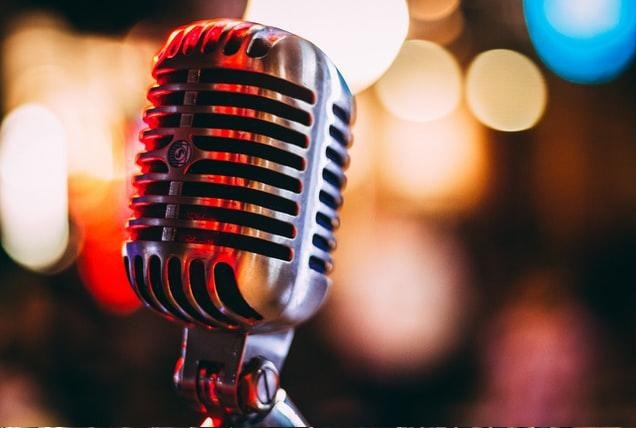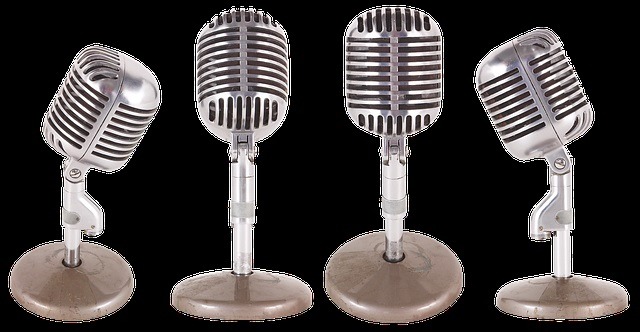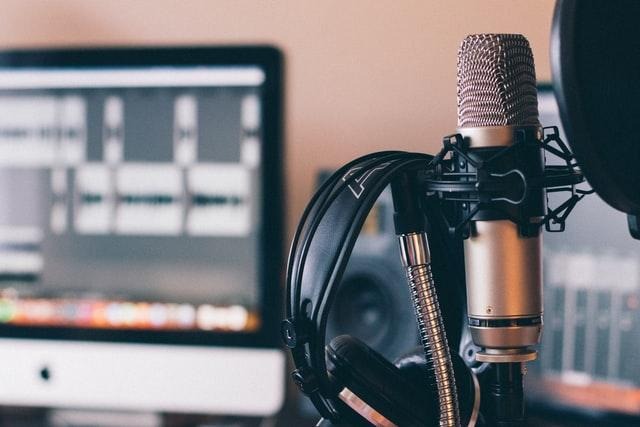Sound quality is important in podcasting. This medium requires an excellent tool for listeners to understand what the host is trying to say. Indeed, effective podcast marketing starts with establishing great communication with your listeners.
Without a good podcast microphone, the goal of creating an effective message to the audience will not be met. A podcast recording with the use of a professional microphone beats one that is produced with just an ordinary microphone.
Some audiophiles believe that old-style microphone types have some advantages over modern ones. Vintage mics are desirable for antique enthusiasts because of their sound, workmanship, or finish. Let’s take a look at why these microphones are the preferred gear of a niche of enthusiasts.
What Is an Old-Fashioned Microphone Called?
You’ve probably seen movies or posters from the past with old-fashioned mics. Elvis Presley is legendarily remembered to be holding one of these microphones in most of his pictures. Also, Marilyn Monroe offered the American soldiers in Korea a special song using one of these old-fashioned mics. These types of mics are called vintage microphones. They are known for the following qualities:
- Ribbon or tube condenser
- More than 50 years old
- Excellent microphones then until now
- The original manufacturer no longer sells them
- Retail price is now higher
- Has a cloned “modern” version
- Still sought after in the industry
The original old-style microphone types can be a bit difficult to find in the market these days. Fortunately, some manufacturers produce clones that carry similar aesthetics yet are donned with contemporary features. If you’re searching for vintage mics to use on your podcast channel, here are some of our suggestions:
AKG Pro Audio Lyra Ultra-HD USB-C Condenser Microphone
AKG is one of the top brands the audio industry relies on. They have provided microphones to top recording studios and concert stages for more than 70 years now. One of their best sellers is the AKG Lyra.
This gear brings people back to the past with its retro microphone appeal, yet pulls them back to the present with its sleek and modern attributes. It has an easy plug-and-play feature that allows users to easily plug the mic to any of their devices and use it conveniently. What makes it perfect for podcasting is its ultra-HD quality audio resolution of 24-bit/192kHz.
Choose any one of the four capture modes available when it comes to how you want to record. Likewise this model comes with a “zero-latency” headphone jack that helps you concentrate more on your recording.
Shure 55SH Series II Dynamic Microphone (the Elvis Microphone)
Want to pose like Elvis? The Shure 55SH Series II Dynamic Microphone is the mic you would want to have for its appealing, vintage look. Don’t be fooled by its 1940s microphone appearance. It is packed with state-of-the-art qualities that will make your podcast stand out.
The Shure 55SH Series II mic comes with a cardioid directional pattern. This special component allows users to minimize sound pickup from any kind of environment. Even if you use them near loudspeakers, it is guaranteed to not produce feedback, unlike other microphones. You can leave them standing on a flat surface or attach them on a stand. Its swivel mount can be tilted 45 degrees forward and 80 degrees backward.
Shure has been used in the industry for decades, so you can be sure you’ve made the right choice when you buy from them. All their products deliver flawless sound consistently.
Monoprice Memphis Blue Classic Dynamic Microphone
Another microphone that has a vintage style is the Monoprice Memphis Blue Classic Dynamic. It is highly developed with different sophisticated elements. This gear, which resembles the look of an old microphone, is specially made for voice amplification. Therefore, it is ideal for your podcasting, streaming, or live performing requirements.
Its supercardioid polar pattern ensures there will be no feedback in your recording. The internal element of this mic is shock-mounted. This means that if you’re recording with a live audience or in a noisy environment, there will be no disturbances that will affect your output. Moreover, this mic is equipped with die-cast zinc metal housing ensuring that it remains protected and will last for years.
CAROL CLM-101 Professional Super-Cardioid Microphone Retro Vintage Look – The Classic Elvis Microphone
Portrays a classic demeanor yet delivers superb performance—that is what is for what the CAROL CLM-101 microphone is known. It also looks like a duplicate of the legendary Elvis mic we all know. This unit was produced by the Carol company, which carries a notable reputation in the audio industry.
Even if you record in a crowded setting, you don’t have to worry because this mic is equipped with an advanced shock-mount system, as well as a Super-Cardioid pickup pattern. These features help in minimizing unwanted noise. What makes this mic different from others is its switch type. It can control acoustic shock when turned on or off. This technology from the Carol company is patented in several countries.
MXL V400 Dynamic Microphone with Vintage Body
The MXL V400 Dynamic Microphone can be placed in line with other retro-style mics because of its vintage body. But the good news is that this gear comes with the latest design elements, both in its interior and exterior parts. The integrated foam windscreen behind the mic’s grills helps users deliver a clear sound. It also filters out plosives and background noise.
Additionally, this mic has a cardioid polar pattern. The sensitivity this feature brings at the front of the mic cuts off any unwanted sound and resists feedback. To add to its many aspects is the built-in shock mount which lessens noise from floor vibrations. According to its manufacturers, this microphone is built to withstand all shows and performances.
Polsen RC-77-U USB Retro Condenser Microphone
Probably one of the easiest mics to use in this list is the Polsen RC-77-U USB Retro Condenser Microphone. It’s not only a feast for the eyes of vintage lovers. This condenser mic can easily be plugged into a Mac or Windows computer. Then, the user can automatically use it for whatever purpose, from recording songs to podcasting.
This mic is designed to have an integrated dual-stage grille installed. It shields the outermost capsule from corrosive moisture. Also, this feature keeps down pops and vocal plosives in the final record. The Polsen RC-77-U makes for an excellent tool for recording vocals, all thanks to its cardioid polar pattern system.
Blue Microphones Yeti Pro
The Blue Microphones Yeti Pro may be last on the list but definitely not the least in appeal and quality. Like other vintage mics mentioned, it can also connect to a device via USB. Aside from being the highest-quality USB microphone, it also has an XLR breakout cable, allowing easy access to different kinds of mixers and other studio gear. With this mic, you’ll never experience any recording delay.
Blue Microphones also takes pride with this mic being equipped with four distinct polar pattern settings, including Cardioid, Stereo, Bidirectional, and Omnidirectional. Plus, it has three custom condenser capsules. These features can seemplesly produce recording quality that is four times better than on CDs. No wonder it’s one of the top choices of podcasters and recording artists.
The Best Podcasting Microphones
The best podcasting microphone for you depends on your budget. Of course, the more you spend, the more quality you can get. An ideal microphone for podcast recording should have an anti-shock mount to filter out vibrations from the keyboard while you’re typing on a desk or any kind of surface. Another preferred element in a podcast mic is the cardioid pickup pattern and pop filter for smoother records. Additionally, choose a microphone that can provide a frequency of at least 16-bit and between 44-50 kHz resolution.
What Accessories Do I Need with My Vocal Microphone?
Now that you have an idea of what microphone you prefer, it’s time to check which accessories are the best complements. Remember that microphones are not the only gear users rely on when they are recording. Here are the essentials:
Cables
High-quality cables with impurity-free copper, quad conductors, and other features can help block noise and interference.
Mic Stands
Using a mic stand can help you get the best possible sound from your microphone and prevent floor-transmitted vibrations from interfering with your recording.
Pop Filters
This accessory’s main job is to prevent plosives that produce low-frequency bumps in the recording.
Portable Vocal Booths
These shields, composed of acoustic absorption material, avoid the bouncing of sounds to other surfaces of the room, which affect your overall sound quality on the mic.
Mic Activators
Their job is to improve signals near your microphone’s source, which results in a clearer, fuller sound before you preamp.
Before recording, always make sure that all your accessories are ready and activated in order to avoid running into problems. Make a list of what accessories you need to bring, whether you’ll be recording in a studio or in a remote environment. Always bring extra accessories just in case there is damage or a shortage.
Conclusion
When looking for a podcasting microphone, most people tend to check on the latest modern units first. However, old-style microphone models also have what it takes to produce quality sound. They may look ancient or can pass as a collector’s item. But today’s top companies have remodeled retro mics with modern technologies and features to provide retro style and quality all in one. Hence, using this kind of microphone can assure you will sound authoritative and smooth on your recordings. Get more tips about choosing the best podcasting microphone here!



